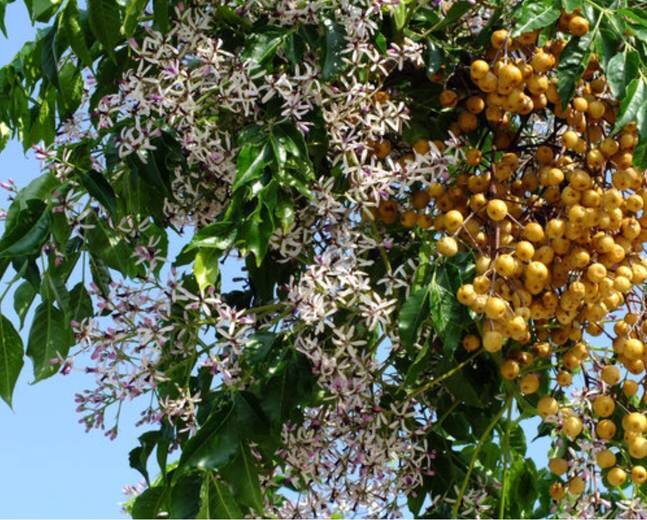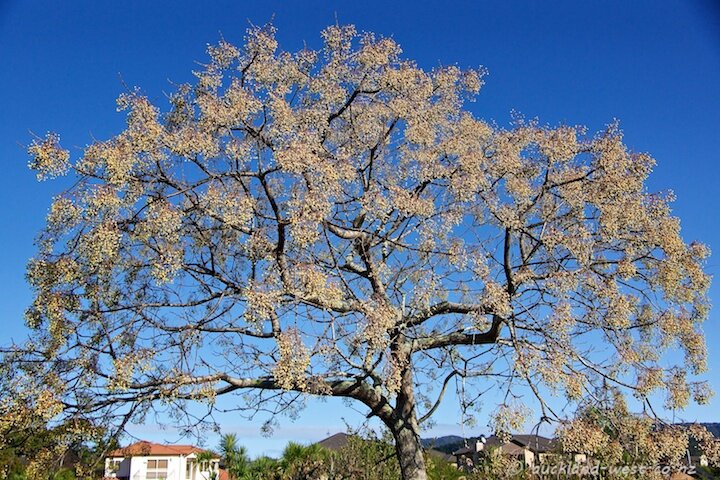Chinaberry Invasive
Tree Stories: Invasive Chinaberry
The Melia azedarach is known by many names, including bead-tree, Cape lilac, Pride of India, Persian lilac, and the one probably familiar to you: chinaberry. The berries were popular ammunition for chinaberry fights during my Gulf Coast childhood.
Despite some pretty names, this tree is one of those we don’t want. Chinaberry is basically an imported weed that has settled comfortably in our ecosystem. It is common on roadsides, at forest margins, and around old homesites. In Galveston it can be found in alleys and front yards.
This deciduous member of the mahogany family was introduced to the US from Asia around 200 years ago as an ornamental, and was planted widely on homesite in southern states. It grows quickly, typically with multiple trunks, to over 20 feet and to 40 in the right conditions. When mature it can be lovely with lacy dark green leaves and multiple dark or reddish-brown branches in a rounded crown.
Spring brings clusters of small, fragrant lavender flowers. They are followed in summer by pale green marble-sized fruits that persist through fall and winter, maturing to light yellow or wrinkled and almost white. Unfortunately, those berries are poisonous to humans and other mammals if consumed in large quantities. Most birds can eat them without harm and spread them widely.
When chinaberry was brought to the US its natural disease and insect enemies did not come along to keep its populations under control. The plant is virtually disease and insect free and resistant to our native insects and pathogens. It adapts to many environmental conditions, and thrives in disturbed or open areas. Chinaberry outcompetes the vegetation that provides appropriate habitat for native critters. It sprouts readily from seeds and from the roots when cut, and shades out other species by forming a dense thicket. The leaf litter produced by Chinaberry affects soil chemistry, and overall reduces the plant diversity in any area in which it grows. Besides the problem of toxicity, fallen berries can create a slippery and sticky mess on sidewalks.
Chinaberry does have some traditional value as an ornamental plant, shade tree, and fuel wood. Its useful timber is of medium density, and ranges in color from light brown to dark red. Seeds were used for rosaries and other beaded products until the emergence of plastics. There are also some applications for medicinal purposes and as a natural pesticide. Cut branches and wrinkled berries are used by florists and landscapers. Many birds do enjoy the fruits without harm, but the flowers reportedly do not attract pollinators.
But these uses are outweighed by chinaberry’s disadvantages. Today it is considered an invasive species in several states. Unfortunately, many nurseries continue to sell the trees, and seeds are also widely available. There are so many excellent choices for shade and landscape trees available that you can surely find a more suitable addition to your garden!
“Tree Stories” is an ongoing series of articles about Island trees, tree care, and tree issues. If you have or know of a special tree on Galveston Island that should be highlighted, please email treesforgalveston@gmail.com. Margaret Canavan is a Galveston resident, a Galveston County Master Gardener, and a member of the Galveston Island Tree Conservancy Board.
Hurricane Ike caused the loss of 40,000 trees on Galveston Island. The Galveston Island Tree Conservancy was formed to address that loss and has replaced over 17,000 through grant-funded plantings and giveaways.


